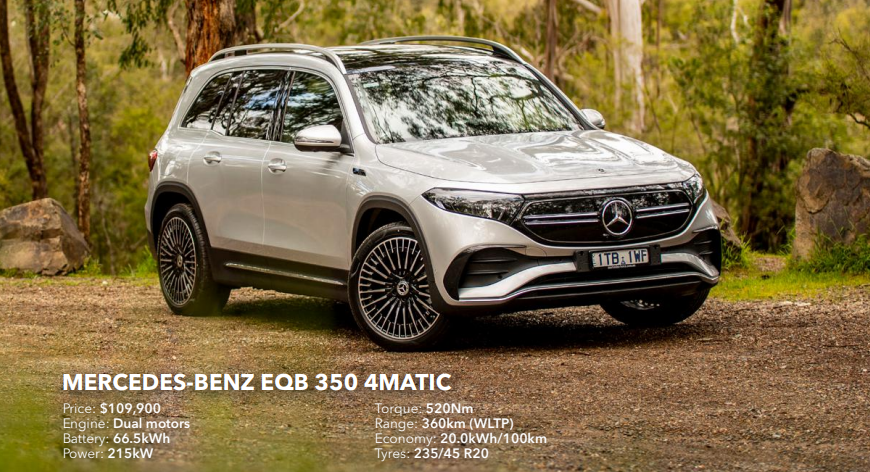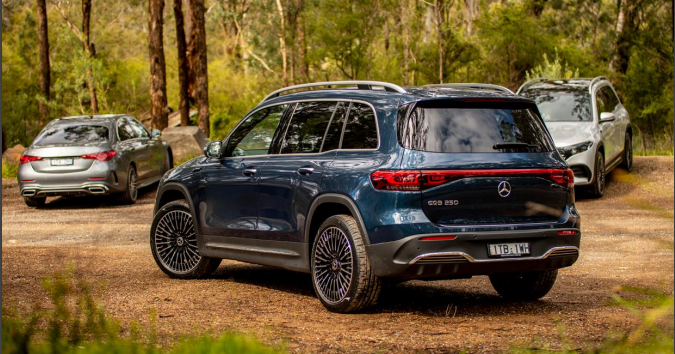
As the electric vehicle market begins to mature and more entrants arrive, we’re starting to see key price segments take shape.
Thought the affordable sub-40k EV is still a flight of fancy, there’s an emerging battle for supremacy in the 50 to 60 grand group.
And inevitably there are also a bunch of cars clashing at the top end of the 80 grand Clean Car Discount threshold.
There’s also a fascinating assortment of premium SUVs priced north of $100,000.
BMW has its $118,900 iX3, Audi has the $151,500 e-tron, Jaguar’s I-Pace starts at $159,900, and there’s also the premium-adjacent Tesla Model Y Performance.
There’s more coming too, like the Q4 e-tron and Polestar 3.
If anyone owns the space now, it’s Mercedes-Benz.
With the arrival of the EQB it now has three dedicated premium plug-in SUVs covering a wide footprint.
For the Goldilocks shoppers among us, the EQB’s balance between the EQA and EQC may be just right, blending dimensions similar to the latter’s with an available seven-seater layout and a friendlier sticker price.
In this case, just right doesn’t exactly fall perfectly between the EQA and EQC.

The EQB is based on the A’s MFA 2 platform, which happens to underpin its direct petrol-sipping cousin, the GLB.
Entry-level EQBs get the A’s powertrain, while the 350 4Matic flagship, featured here, cops dual motors and all-wheel drive.
It all looks very tempting on paper, especially when you consider the pricing of all the aforementioned premium names and realise that this dual-motor, all-wheel drive 350 undercuts them all with its $109,900 sticker price.
Save for that pesky Tesla, anyway.
The 350’s dual motors produce 215kW and 520Nm, which is good enough for it to hit 100km/h in 6.2 seconds according to Mercedes.
A 66.5kWh battery is shared by the 250 and the 350, with the 350’s range rated for 360km on the WLTP cycle.
Neither of these figures is particularly outstanding, particularly with the number of EVs claiming they can do more than 400km.
In practice, the 350 feels quicker than an SUV of its size and demeanour ought to.
On range, we expect most drivers would be able to extract more than 300km from a full battery.
There’s another issue to address.
The seven-seat arrangement, very much something that’s in demand locally, can only be had in the single-motor 250 grade.
Given that the 250 uses exactly the same powertrain as the smaller and lighter EQA, it’s no surprise that it’s quite sluggish.
That’s especially true when contrasted with the 350’s straightline capabilities.
The gulf between the two grades in performance is large enough (and the $10,000 price gap small enough) that I have a hard time recommending the 250.
Not offering seven seats in the 350 is a grand opportunity missed.
Still, there’s more to the EQB than its seating arrangement.
For one, its carryover interior is excellent.
The dashboard and dual 10.25-inch screen layout should be very familiar by now, and there’s little wrong with that when the fixtures and surfaces are of such solid quality.
Admittedly there are some minor niggles.
Some of the plastics and switchgear feel a little cheap, and the lack of wireless Android Auto or Apple CarPlay feels a little last-generation.
The level of standard kit is reasonably generous.
Apple CarPlay, Android Auto, dual-zone climate, radar cruise, active lane keep assist, active blindspot assist, park assist and a 360-degree camera are all standard.
Inevitably there are a few features locked behind optional extra packages, but most are fairly sensible, like leather upholstery and Burmester audio.
Credit where it’s due, too.
Mercedes has given the entry-level 250 almost all the same tech kit as the 350.
If you’re worried that all the EQA handme-downs mean the EQB is similarly proportioned on the inside, don’t be.
There’s an extra 100mm between its wheels, with most of that leading to much improved second row legroom.
If you’re particularly tall, your ride might be impacted by the EQB’s quite tall floor (shifted to accommodate the battery underneath), but most passengers will be fine.
The EQB’s boxy shape helps facilitate one of the most open glasshouses of any contemporary SUV, making this cabin one of the most open and airy in class.
All up, it’s a pleasant, tech-filled place to be.
The much-hyped third row seats (again, not present here) are fairly typical for the space, insofar as they’re really only suited for children.
Nevertheless, they’re a handy extra for tackling the Saturday morning soccer run.
They also don’t compromise boot space; seven-seater models have 130 litres/670 litres with the third row in place or lowered, respectively, while five-seaters can house 650 litres with the second row up.
The EQB can’t claim to move the needle in the electric vehicle space.
It is a well-rounded, competent, Mercedes product that slides into the three-pointed star’s line-up seamlessly.
Buyers who looked at the EQA and wanted a little more oomph and practicality will be more than happy behind the wheel of one of these.
I just wish they could’ve given it those extra seats.








